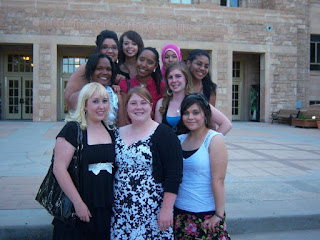 |
| Rick Matlock has been with Wyoming EPSCoR since 2002. |
“When I first moved here, I lived in the dorms,” Rick said.
“I moved up here from New Mexico and the blizzards were just enormous the first
couple of years. I just despised it. And, it was a small town, with absolutely
nothing to do. I just despised that too.” Rick laughs at this now and adds,
“But the way to live in Laramie is to accept your surroundings and to be part
of the outdoor scene.”
And that is exactly what Rick has done. While today he
enjoys snowboarding, snowshoeing, hiking and fishing in the surrounding
mountains, those activities were not what brought him to the University of
Wyoming. He came instead to pursue a degree in psychology, in order to reach
his goal to help people.
“When I first got out of high school, I wanted to be a helping-people-person,”
Rick says. “I wanted to help the seriously mentally ill and depressed.”
After finishing his degree, Rick worked in the medical field
in a variety of areas including an inpatient psychiatric unit, a home for at
risk youth and the local crisis center. While these experiences were rewarding,
each in their own way, they also took their toll on him and after almost twelve
years, Rick found himself burnt out.
“I kind of found out that this wasn’t really my calling,”
Rick says. “So, I decided to try to put my psychology degree to use somewhere
else.”
He came to UW and worked at the graduate school
administrative office wanting to start into academic advising.
“I enjoyed that experience,” Rick says. “But then the job
opened up to run the undergraduate program here at EPSCoR and I decided to take
it.”
Rick is in charge of EPSCoR programs, such as our
Undergraduate Research Fellowships and Undergraduate research day, which
support students going into the science fields, but he makes sure things run
smoothly for our grant projects.
“What I do now is, I administer or organize the various
aspects of the EPSCoR goals,” Rick says. “It is making sure that everything is
staying on track, making sure the EOD (education, outreach and diversity)
components are coming together, and making sure we stay on track with the
budget.”
While he is no longer helping people in the way he
originally set out to do, he is helping to make a difference in the lives of
future scientists through his work with our undergraduate programs. This work is
inspiring for several reasons.
“The most rewarding part is working with a diverse group of
people,” Rick says. “I am able to work with scientists I wouldn’t ever normally
meet and I get to work with a lot of great students through undergraduate
research. I am amazed by all the different things the students are doing.”
As a student in college, Rick couldn’t imagine ever saying
this, but today he loves living in Laramie. “It’s got the best of everything,
essentially.”
By Kali S. McCrackin
Photo by Leah Yetter





